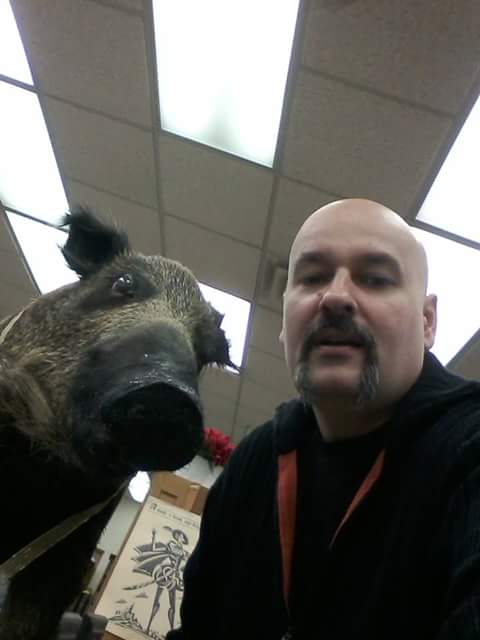The Power of Cold (and Hot) II: Thermoelectric Generator
A few posts ago (The Power of Cold and Hot) we looked at a Stirling Engine, which converted temperature differences into pressure and fast movement.
Now we are going to make a thermoelectric generator (and a thermosistor).
A thermoelectric generator converts temperature differences into electric voltage.
Two copper wires heated until they are crusted with cuprous and cupric oxide.
When touching, the wires are pressure sensitive and heat sensitive where they meet (pressure and heat at the junction cause Ohm resistance to drop). This is a thermosistor: resistance varies with temperature.
Heating only one wire causes Voltage to be produced. This is a thermoelectric generator / thermocouple. With only a butane barbeque lighter I can produce a consistent -5.2 mV (millivolt) when I apply ice to the other wire.
The weird thing is that the eV (electron Volt) work function is 5.2-5.6eV for cupric oxide and 4.8-4.9eV for cuprous oxide. Coincidence? Yeah, probaby...
Store bought thermocouples for home appliances produce 25-30 mV with 30mV being the norm.
I've looked at the work of Nyle Steiner who is a real whiz in many areas of electronics. Here's how I built my version:
Copper wire of equal lengths.
Wood disk and mounting screws.
Heating with a propane torch. It's hard to see here but the blue flame of the torch turns green after passing the copper wires.
Below you can see the scale left after heating. Red is Cu2O which is cuprous oxide (Copper I). Black is CuO which is the cupric oxide (Copper II). These oxides are used in semiconductors.
With two copper wires the hot wire output is negative voltage and the cooler wire is positive. Nyle Steiner hooked 16 of these wires together and heated them. The result was enough voltage to light up and LED!
Simple thermocouples like this are used to measure temperature in appliances: different voltages equal different temperatures. This is because temperature gradients produce an electromotive force (emf).
Here's a picture of my new Pyrometer (like a thermometer but for surface temperature). It can read up to 800° F and takes no batteries since the operating voltage comes from the physics we're discussing in this post.
Here's a picture of my new Pyrometer (like a thermometer but for surface temperature). It can read up to 800° F and takes no batteries since the operating voltage comes from the physics we're discussing in this post.
Thermometers measure temperature. Pyrometers measure surface temperature. My pyrometer has a blunt tip for placing near the exterior surfaces of things that are very, very hot. Most thermometers are pointy for jabbing into things for interior readings: into a roasting Thanksgiving turkey, into container of boiling liquid, into your mouth, etc.
Newer pyrometers use infrared, lasery thingies that can tell you if the outside of your turkey is too hot from the other side of the kitchen! Here's a photo of mine:
Of course that's pretty useless since you want to measure the inside of the turkey. The problem is that thermometers need to touch what they're measuring, which is fine for normal things but not great touching something that is 800° F or way hotter like smelting metal! Because they don't have to make physical contact you can use a pyrometer to measure the temperature of a moving object, like a stream turbine.
Nowadays pyrometers also have probes for jabbing into things, so the lines are blurring even more. Thermometers generally are more delicate, require contact and can't handle high temperatures.
These sunny-side-up-eggs are starting to burn!
My pyrometer above is made by West Instruments, another company that makes this sort of thing is Borg. Yes, the same Borg from Star Track, or was is Star War? Anyway, BorgWarnet makes stuff for kitchen ovens, which is where I got the circuit board below, although the sensing portions and timer were probably made by Diehl. I think they're the same Borg that makes turbochargers for Detroit Diesel up the street.
...anyway, back to metal thermocouples:
With wires of two different materials, copper and steel for example, you create a closed loop thermocouple that is very similar to our Sterling Engine...but with electromagnetic waves!
All you have to do is solder the two ends of the copper and steel wire together. Then apply heat to one of the solder joints. The greater the temperature differential-the more mV it will produce. Since it's a closed loop of (two) wire there are no "ends" for positive or negative multimeter attachment so it's easiest to use a compass needle to observe electric (and thus magnetic) production.
This is how Seebeck Effect devices such as this, Peltier Cooling Modules and Stirling engines can be used to produce electricity-some improvised units can make enough to charge a cellphone!
Like most things electromagnetic, you can use the output (voltage) and get the input (heat) just by reversing things. Running electricity through a shorted wire produces heat. This is called ohmic heating / Joule heating. It's why short circuits get hot, but it's also how a toaster works, and hot wire saws for sculpting sheets of foam for car seats.
Like most things electromagnetic, you can use the output (voltage) and get the input (heat) just by reversing things. Running electricity through a shorted wire produces heat. This is called ohmic heating / Joule heating. It's why short circuits get hot, but it's also how a toaster works, and hot wire saws for sculpting sheets of foam for car seats.
EMF: electromotive feline. The moving clouds and warm sun make me move back and forth. Meow!





















































